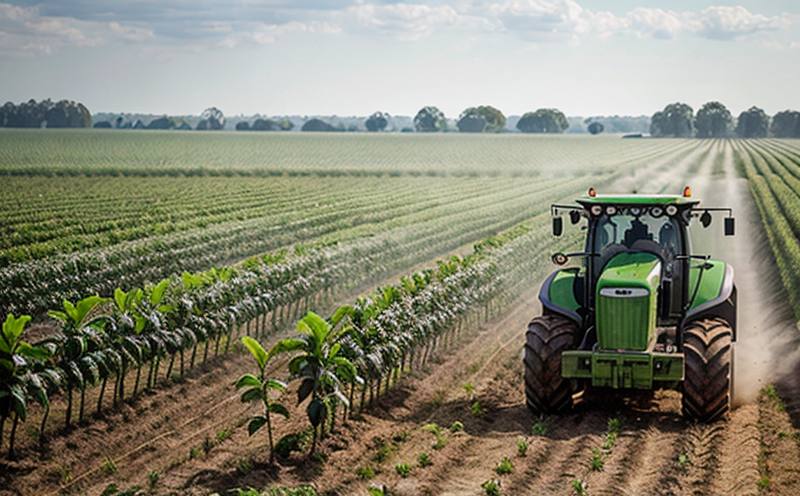ISO 18730 Residue Testing of Agricultural Chemicals by LC MS
The ISO 18730 standard provides a comprehensive approach to the residue analysis of agricultural chemicals in plant matrices. This method uses Liquid Chromatography-Mass Spectrometry (LC-MS) for accurate and reliable quantification, ensuring compliance with international standards.
ISO 18730 is particularly relevant for quality managers, procurement officers, R&D engineers, and compliance officers working in the agricultural sector. The standard specifies procedures that ensure the correct identification of residues from plant protection products (PPP) used during cultivation or processing.
The testing process begins with a thorough sample preparation to extract residues from plant material. This may involve mechanical disruption, solvent extraction, and purification steps. Once prepared, these samples undergo chromatographic separation followed by mass spectrometric analysis for precise identification and quantification of the residues present.
LC-MS is chosen for its high sensitivity and specificity, making it ideal for detecting even trace amounts of agricultural chemicals in food or feed products. Compliance with ISO 18730 ensures that testing aligns with international standards, thereby enhancing trust among stakeholders and consumers.
The standard also emphasizes the importance of method validation to ensure accuracy and reproducibility. This includes establishing appropriate calibration curves, determining detection limits (DL) and quantification limits (QL), and validating recovery rates through spike studies.
Compliance with ISO 18730 is crucial for maintaining food safety standards globally. By adhering to this standard, laboratories can ensure that agricultural products meet regulatory requirements set by various countries around the world.
| Parameter | Description |
|---|---|
| Sensitivity | LC-MS provides excellent sensitivity for detecting trace amounts of residues. |
| Specificity | Achieved through accurate mass measurement providing unique fingerprints for each compound. |
| Reproducibility | Standard operating procedures ensure consistent results across different analyses. |
| Detection Limits (DL) | Typically in the ppb range, ensuring detection of even low levels of residues. |
| Quantification Limits (QL) | Slightly higher than DL but still very sensitive for quantifying residues accurately. |
The LC-MS system used for this testing is a high-performance instrument capable of handling complex samples with ease. It integrates advanced software that facilitates data interpretation and reporting, making the entire process efficient and reliable.
- Sample preparation: Ensures uniformity and consistency in residue extraction.
- Chromatographic separation: Separates different components allowing for accurate identification.
- Mass spectrometric analysis: Provides precise measurement of molecular weights aiding in compound identification.
This method is not only useful for regulatory compliance but also supports research and development efforts aimed at optimizing crop yields while minimizing environmental impact. By ensuring that agricultural chemicals remain within safe limits, ISO 18730 contributes significantly to sustainable agriculture practices worldwide.
Applied Standards
The ISO 18730 standard integrates several key components from other relevant international standards such as ISO 3696, which deals with the analysis of pesticides in biological materials. The integration ensures a robust and comprehensive approach to residue testing.
ISO 18730 aligns with broader agricultural chemical safety frameworks set forth by FAO/WHO Codex Alimentarius Commission recommendations. These guidelines ensure that all methods used are scientifically sound, reliable, and protective of public health.
The standard’s methodology is designed to be adaptable to different types of plant matrices commonly encountered in agriculture. Whether it's fruits, vegetables, grains, or processed products derived therefrom, ISO 18730 provides a versatile framework for residue analysis.
By adhering to these applied standards, laboratories can ensure consistent and accurate results across diverse sample types, contributing to the integrity of global food safety systems.
Quality and Reliability Assurance
The implementation of ISO 18730 residue testing by LC MS involves rigorous quality control measures aimed at maintaining high standards throughout the entire analytical process. These measures include strict adherence to validated methods, regular calibration checks, and proficiency testing.
Regularly calibrated instruments are essential for obtaining reliable data. This ensures that each measurement accurately reflects the true concentration of residues in the sample being analyzed. Proficiency testing further reinforces reliability by simulating real-world conditions under controlled laboratory settings.
The standard also mandates thorough documentation of all analytical steps, including sample preparation, instrument operation, and interpretation of results. Comprehensive records help trace any discrepancies back to their source, facilitating continuous improvement efforts within the laboratory environment.
Training programs for personnel involved in performing these tests are crucial too. Continuous professional development ensures that staff remain up-to-date with advancements in analytical techniques and best practices recommended by international bodies like ISO itself.
In summary, quality assurance is integral to achieving accurate residue testing outcomes compliant with ISO 18730 requirements. It encompasses multiple layers of control designed to minimize errors and maximize confidence in the results produced.
Use Cases and Application Examples
- Regulatory compliance: Ensuring that agricultural products meet strict residue limits imposed by regulatory authorities.
- R&D support: Identifying potential issues early during product development cycles to prevent costly rework later on.
- Supply chain management: Verifying the integrity of supply chains by regularly checking for unwanted residues at various stages.
- Consumer protection: Providing assurance that food items sold are free from harmful substances exceeding permissible levels.
| Use Case | Description |
|---|---|
| Supply Chain Verification | Regular checks ensure trustworthiness of suppliers and maintain product quality throughout distribution networks. |
| R&D Optimization | Identifying problematic residues allows for targeted adjustments in formulations or processing methods. |
| Consumer Assurance | Results reassure customers about the safety of purchased goods, fostering brand loyalty and trust. |
The application examples demonstrate how ISO 18730 residue testing by LC MS plays a vital role in various sectors including food manufacturing, pharmaceuticals, and environmental monitoring. Its versatility makes it indispensable for organizations committed to producing safe, high-quality agricultural products.





